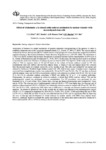Use este identificador para citar ou linkar para este item:
http://www.alice.cnptia.embrapa.br/alice/handle/doc/1024379| Título: | Effect of trichostatin a in cloned cattle embryo production by nuclear transfer with mesenchymal stem cells. |
| Autoria: | SILVA, C. G.  CUMPA, H. C. B.   FONSECA NETO, A. M. da   MARTINS, C. F.   BÁO, S. N.   |
| Afiliação: | C. G. SILVA, UNIVERSIDADE DE BRASÍLIA HEIDI CHRISTINA BESSLER CUMPA, CPAC ALVARO MORAES DA FONSECA NETO, CPAC CARLOS FREDERICO MARTINS, CPAC S. N. BÁO, UNIVERSIDADE DE BRASÍLIA. |
| Ano de publicação: | 2015 |
| Referência: | Animal Reproduction, v. 12, n. 3, p. 812, Jul./Sept. 2015. |
| Conteúdo: | The objective of this study was to test the effect of TSA in exposure times of 20 and 25 hours in the culture of bovine embryos cloned by NT with mesenchymal stem cells (MSCs) derived from adipose tissue. It can be concluded that the use of TSA had no significant effect in improving the rates of cleavage and development of bovine embryos by nuclear transfer with MSCs from adipose tissue. However, additional studies to evaluate the quality and embryos of the methylation pattern should be conducted to better understand the effects of TSA in embryos cloned with this cell type. |
| NAL Thesaurus: | Histone deacetylase Cloning (animals) Epigenetics |
| Tipo do material: | Resumo em anais e proceedings |
| Acesso: | openAccess |
| Aparece nas coleções: | Resumo em anais de congresso (CPAC)  |
Arquivos associados a este item:
| Arquivo | Descrição | Tamanho | Formato | |
|---|---|---|---|---|
| 34712.pdf | 648,6 kB | Adobe PDF |  Visualizar/Abrir |









